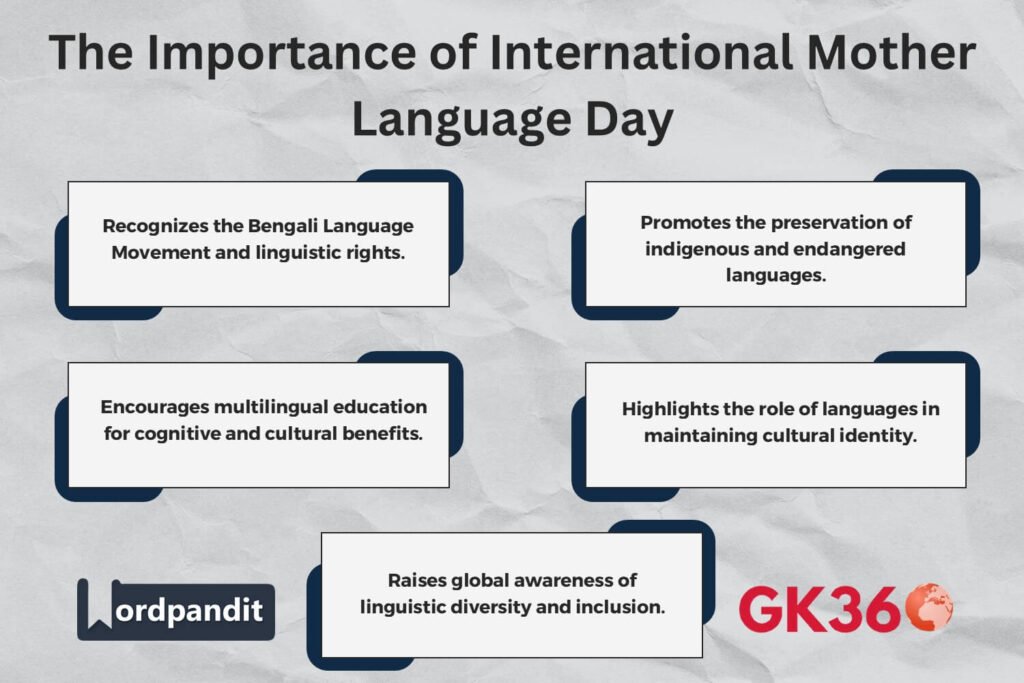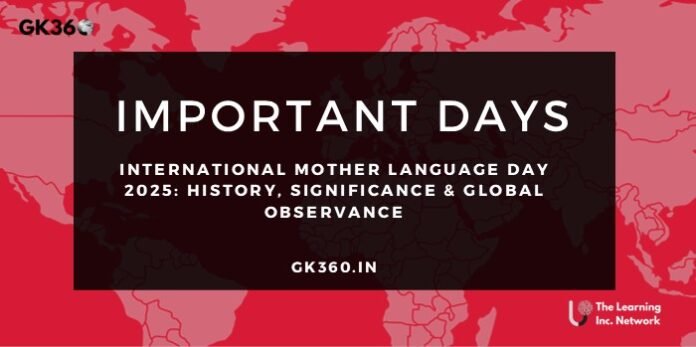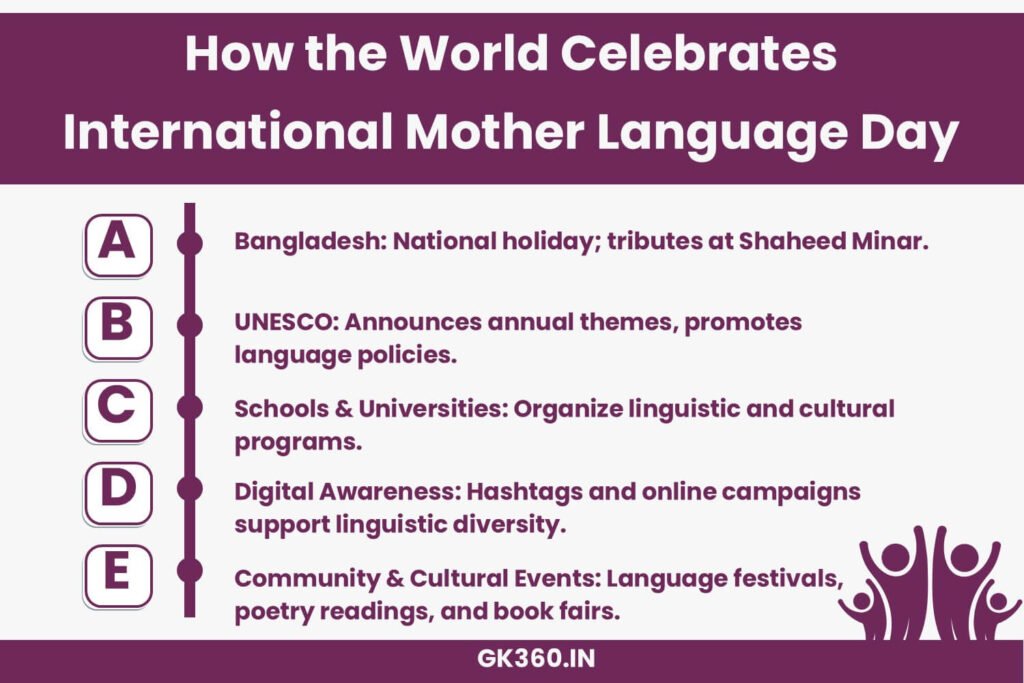International Mother Language Day 2025: History, Significance & Global Observance

Table of Contents
- Introduction
- History of International Mother Language Day
- Why International Mother Language Day Matters
- How International Mother Language Day is Celebrated Worldwide
- Challenges in Language Preservation
- How to Support Linguistic Diversity
- FAQs
- Conclusion
Introduction
International Mother Language Day is celebrated annually on February 21st to promote linguistic and cultural diversity worldwide. Proclaimed by UNESCO in 1999, this observance honors the Bengali Language Movement of 1952, a historic struggle that led to the recognition of Bengali as an official language in then East Pakistan (now Bangladesh).
In 2025, International Mother Language Day continues to highlight the importance of preserving linguistic heritage, promoting multilingual education, and raising awareness about endangered languages.
History of International Mother Language Day
The Bangladesh Language Movement
Following the partition of British India in 1947, the newly formed Pakistan was divided into West Pakistan (present-day Pakistan) and East Pakistan (now Bangladesh). Although Bengali (Bangla) was spoken by a majority of the population in East Pakistan, the government attempted to impose Urdu as the sole national language in 1948. This sparked widespread protests among Bengalis, who demanded linguistic rights.
February 21, 1952: A Historic Sacrifice
On February 21, 1952, students in Dhaka staged a demonstration demanding Bengali’s recognition as a national language. The police opened fire, killing three students and injuring many others. These martyrs—Salam, Rafiq, Barkat, and Jabbar—became national heroes. Their sacrifice ultimately led to Bengali being recognized as one of Pakistan’s official languages in 1956 and later as the national language of Bangladesh after independence in 1971.
UNESCO’s Recognition & Global Adoption
In 1998, two Bengali expatriates, Rafiqul Islam and Abdus Salam, proposed to UNESCO that February 21st be recognized globally as International Mother Language Day to promote linguistic diversity.
On November 17, 1999, UNESCO’s 30th General Assembly unanimously declared February 21st as International Mother Language Day. The observance was officially celebrated for the first time in 2000, and today, it is recognized worldwide.
Why International Mother Language Day Matters
Promoting Linguistic Diversity
With over 7,000 languages spoken globally, International Mother Language Day reminds us of the need to preserve indigenous languages and support minority languages that are at risk of extinction.
Encouraging Multilingual Education
UNESCO advocates for bilingual and multilingual education, enabling children to learn in their mother tongue first before acquiring additional languages. This approach improves cognitive development and academic success.
Preserving Cultural Heritage
Language is an integral part of cultural identity. When a language disappears, a part of history, traditions, and knowledge is lost forever.
Raising Awareness of Language Endangerment
According to UNESCO, nearly 40% of the world’s languages are endangered due to urbanization, globalization, and lack of institutional support. This day encourages action to document, revive, and sustain at-risk languages.
How International Mother Language Day is Celebrated Worldwide
1. Observance in Bangladesh
- Bangladesh declares February 21st a national holiday.
- People pay homage at Shaheed Minar (Martyrs’ Monument) in Dhaka.
- Schools and universities organize language-themed competitions, poetry recitations, and seminars.
2. UNESCO’s Global Initiatives
- UNESCO announces an annual theme focused on a linguistic issue.
- Governments and NGOs organize discussions on language policies and education.
3. Multilingual Events and Educational Programs
- Schools worldwide encourage students to speak in their mother tongue.
- Cultural organizations host language festivals, book fairs, and storytelling sessions.
4. Digital Campaigns and Awareness Drives
- Hashtags like #MotherLanguageDay and #LinguisticDiversity trend on social media.
- Online platforms promote language-learning resources and initiatives for endangered languages.
Challenges in Language Preservation
- Urbanization & Globalization – Many speakers of indigenous languages shift to dominant languages like English, Mandarin, or Spanish for economic opportunities.
- Lack of Institutional Support – Governments often prioritize national or colonial languages in education and administration.
- Cultural Homogenization – Western media, entertainment, and technology favor a few dominant languages, reducing exposure to minority languages.
- Limited Digital Representation – Most online content is in major languages, making it difficult for smaller languages to thrive in the digital world.
How to Support Linguistic Diversity
- Encourage Mother Tongue Education – Schools should promote bilingual/multilingual instruction.
- Support Language Documentation – Researchers and linguists should work to record endangered languages.
- Promote Cultural Programs – Organize festivals, folk music events, and literature competitions.
- Use & Share Native Languages – Speak, write, and create digital content in your mother tongue.
FAQs
Why is International Mother Language Day celebrated on February 21st?
🔹 It honors the martyrs of the 1952 Bengali Language Movement, who fought for the right to speak their mother tongue.
How many languages are at risk of extinction?
🔹 UNESCO estimates that around 40% of the world’s 7,000 languages are endangered.
What is UNESCO’s role in language preservation?
🔹 UNESCO promotes multilingual education, funds language documentation projects, and raises awareness about endangered languages.
How can I participate in International Mother Language Day?
🔹 Learn a new language or practice your mother tongue.
🔹 Support organizations working to preserve indigenous languages.
🔹 Share social media posts using #MotherLanguageDay.
What is the theme for International Mother Language Day 2025?
🔹 UNESCO will announce the official theme for 2025 closer to the observance date.
Conclusion
International Mother Language Day 2025 is more than just a commemoration—it is a call to action to preserve, protect, and promote the world’s linguistic diversity. The ability to speak in one’s mother tongue is not just a fundamental human right but also a vital component of cultural identity and heritage preservation.
Languages are not just means of communication; they hold within them the history, traditions, and wisdom of entire civilizations. Yet, with nearly 40% of languages at risk of extinction, the urgency to act has never been greater.
By supporting multilingual education, documenting endangered languages, and embracing linguistic diversity, we contribute to a more inclusive, culturally rich world. Schools, governments, and communities must work together to ensure that future generations have access to their native languages and that no language is left behind.
Key Takeaways Table
| Aspect | Details |
|---|---|
| Historical Significance | Commemorates the 1952 Bengali Language Movement and linguistic rights. |
| First Observance | Declared by UNESCO in 1999; first celebrated in 2000. |
| Main Objective | Promotes linguistic diversity, multilingual education, and language preservation. |
| Endangered Languages | Nearly 40% of global languages are at risk of extinction. |
| Educational Importance | Supports mother-tongue-based education for better learning outcomes. |
| Global Recognition | Officially observed worldwide with cultural events, digital campaigns, and academic programs. |
| Call to Action | Encourages language documentation, policy changes, and inclusive linguistic practices. |
Related Terms:
- International Mother Language Day 2025
- Bengali Language Movement 1952
- UNESCO Language Diversity
- Multilingual Education Benefits
- Endangered Languages Awareness
- Linguistic Diversity and Inclusion
- Cultural Identity and Languages
- Language Preservation Strategies
- Shaheed Minar Tribute 2025
- UNESCO Language Policies






